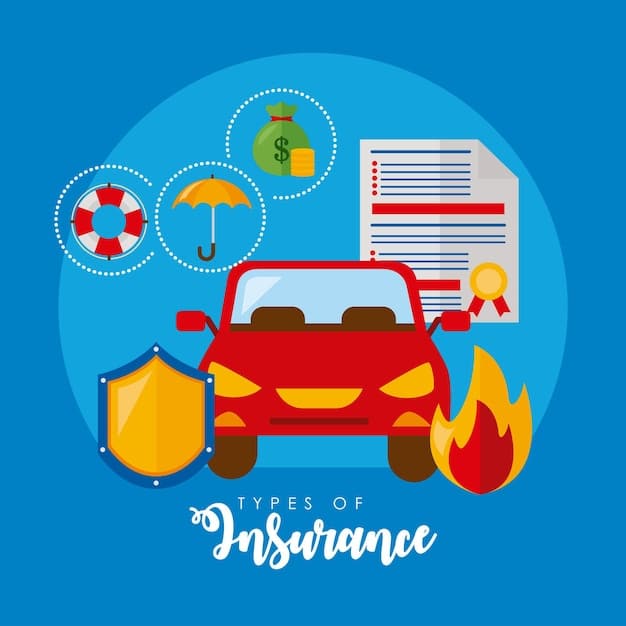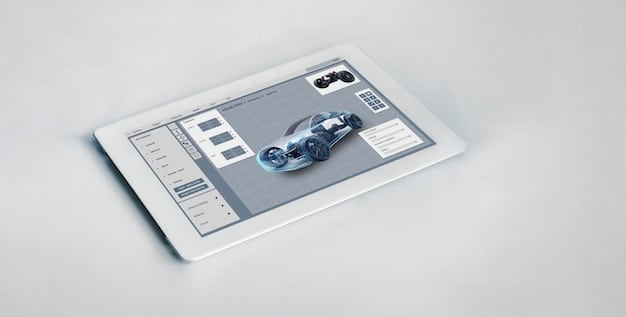Buying Guide: Selecting the Right Car Insurance Policy in 2025

Selecting the right car insurance policy in 2025 requires understanding evolving factors like advanced vehicle technology, personal needs, and comparing quotes from multiple providers to ensure comprehensive and affordable coverage.
Navigating the world of car insurance can feel overwhelming, especially with the constant changes in technology and regulations. This buying guide: selecting the right car insurance policy in 2025 aims to simplify the process, ensuring you get the best possible coverage for your needs and budget.
Understanding Car Insurance Basics
Before diving into the specifics of selecting a policy for 2025, it’s crucial to grasp the fundamental concepts of car insurance. A clear understanding of these basics will empower you to make informed decisions.
Let’s break down the core components of car insurance to ensure you’re well-versed in the terminology and coverage options.
Types of Coverage
Car insurance policies typically include several types of coverage, each designed to protect you in different situations.
- Liability Coverage: This covers damages and injuries you cause to others in an accident. It’s often required by law.
- Collision Coverage: This pays for damage to your car if you collide with another vehicle or object, regardless of who is at fault.
- Comprehensive Coverage: This covers damages to your car from non-collision events like theft, vandalism, weather damage, and animal strikes.
- Uninsured/Underinsured Motorist Coverage: This protects you if you’re hit by a driver who doesn’t have insurance or doesn’t have enough to cover your damages.
- Personal Injury Protection (PIP): This covers medical expenses and lost wages for you and your passengers, regardless of who is at fault.
Key Terms
Understanding common car insurance terms is essential for navigating your policy.
- Premium: The amount you pay regularly (monthly or annually) for your insurance coverage.
- Deductible: The amount you pay out of pocket before your insurance coverage kicks in. A higher deductible usually means a lower premium.
- Policy Limits: The maximum amount your insurance company will pay for a covered claim.
- Claim: A request for payment from your insurance company for a covered loss.

By understanding these basics, you’ll be better equipped to evaluate your insurance needs and choose the right policy for 2025. Consider how each type of coverage applies to your specific circumstances.
Factors Influencing Car Insurance Rates in 2025
Several factors can influence the cost of your car insurance premium. Understanding these elements will help you anticipate potential changes and find ways to save money.
In 2025, traditional factors will continue to play a role, but new technologies and trends are also shaping insurance rates.
Driving History and Demographics
Your personal driving record and demographic information are significant factors in determining your insurance rates.
Insurers assess risk based on your history and characteristics:
- Driving Record: A clean driving record with no accidents or tickets will typically result in lower premiums.
- Age and Gender: Younger drivers and, statistically, young male drivers often face higher rates due to their perceived higher risk.
- Location: Urban areas with higher traffic density and crime rates tend to have higher insurance costs than rural areas.
- Credit Score: In many states, your credit score can impact your insurance rates. A good credit score may result in lower premiums.
Vehicle Type and Technology
The type of vehicle you drive and its technological features also play a role in determining your insurance rates.
Advanced safety features can sometimes lead to lower premiums, but other factors related to the vehicle can increase costs:
- Vehicle Safety Features: Cars with advanced safety features like automatic emergency braking, lane departure warning, and adaptive cruise control may qualify for discounts.
- Repair Costs: Expensive vehicles with complex repair needs can lead to higher insurance rates.
- Electric and Hybrid Vehicles: The growing popularity of electric and hybrid vehicles may influence insurance rates due to their unique repair requirements and battery replacement costs.
Being aware of these factors can help you make informed decisions when choosing a vehicle and managing your driving habits. Consider how these elements may evolve in 2025 and beyond.
The Rise of Telematics and Usage-Based Insurance
Telematics and usage-based insurance (UBI) are becoming increasingly popular, offering personalized insurance rates based on your actual driving behavior.
These technologies provide real-time data that insurers use to assess risk more accurately.
How Telematics Works
Telematics devices, often smartphone apps or small devices installed in your car, track various aspects of your driving.
These devices collect data on:
- Speed: Monitoring your speed and identifying instances of speeding.
- Hard Braking: Detecting instances of sudden and hard braking, which can indicate risky driving.
- Mileage: Tracking the number of miles you drive, as lower mileage often correlates with lower risk.
- Time of Day: Analyzing when you drive, as driving during high-risk times (e.g., late at night) may increase your risk assessment.
Benefits of Usage-Based Insurance
UBI can offer several advantages for drivers, particularly those who demonstrate safe driving habits.
Potential benefits include:
- Personalized Rates: You may qualify for lower premiums based on your actual driving behavior, rather than broad statistical averages.
- Feedback and Improvement: UBI programs often provide feedback on your driving habits, helping you identify areas where you can improve your safety.
- Potential Discounts: Many insurers offer upfront discounts for enrolling in UBI programs, with the potential for further savings based on your performance.
Consider whether telematics and UBI are right for you, weighing the potential benefits against any privacy concerns. As these technologies become more sophisticated in 2025, understanding their implications is crucial.
Comparing Car Insurance Quotes Effectively
One of the most important steps in selecting the right car insurance policy is to compare quotes from multiple providers. This ensures you’re getting the best possible coverage at a competitive price.
A systematic approach to comparing quotes can save you time and money.
Gathering Information
Before requesting quotes, gather all the necessary information about yourself, your vehicle, and your driving history.
This information typically includes:
- Personal Information: Your name, address, date of birth, and driver’s license number.
- Vehicle Information: The make, model, year, and VIN (Vehicle Identification Number) of your car.
- Driving History: Details of any accidents, tickets, or moving violations you’ve had in the past few years.
- Current Insurance Information: Details of your existing insurance policy, including coverage levels and deductibles.
Online Comparison Tools
Several online tools can help you compare car insurance quotes from multiple insurers at once. These tools streamline the process and save you time.
Some popular options include:
- NerdWallet
- The Zebra
- Compare.com
It is important to verify the providers listed and to compare them to make sure they are viable options.
Understanding Coverage Options
When comparing quotes, pay close attention to the coverage options and policy limits offered by each insurer.
Ensure you’re comparing apples to apples by:
- Matching Coverage Levels: Requesting quotes for the same liability limits, deductibles, and other coverage options across all insurers.
- Considering Additional Coverage: Evaluating whether you need additional coverage like gap insurance, rental car reimbursement, or roadside assistance.
- Reading the Fine Print: Carefully reviewing the policy terms and conditions to understand what is and isn’t covered.

By gathering accurate information and comparing quotes thoroughly, you can make an informed decision and secure the best car insurance policy for your needs in 2025.
Emerging Technologies and Their Impact on Car Insurance
The automotive industry is rapidly evolving, with new technologies like autonomous driving and advanced driver-assistance systems (ADAS) poised to transform car insurance.
Understanding these developments is crucial for anticipating future changes and adapting your insurance strategy.
Autonomous Driving Technology
Self-driving cars have the potential to significantly reduce accidents and change the landscape of car insurance.
However, several challenges and considerations remain:
- Liability in Accidents: Determining liability in accidents involving autonomous vehicles will require new legal frameworks and insurance models.
- Data Security and Privacy: Autonomous vehicles generate vast amounts of data, raising concerns about data security and privacy.
- Insurance Costs for Autonomous Features: The cost of insuring vehicles with advanced autonomous features may initially be higher due to the complexity of repairs and potential technology failures.
As autonomous driving technology becomes more prevalent, insurance companies will need to adapt their policies and pricing models. Consider how these changes might affect your insurance needs in 2025 and beyond.
The Impact of ADAS
Advanced driver-assistance systems (ADAS) are already impacting car insurance by helping to prevent accidents and reduce the severity of collisions.
Features like automatic emergency braking, lane departure warning, and adaptive cruise control can:
- Reduce Accident Rates: ADAS technologies can significantly reduce the likelihood of accidents, leading to lower insurance claims.
- Lower Repair Costs: By preventing or mitigating collisions, ADAS can help lower repair costs for insurers.
- Potential for Discounts: Insurers may offer discounts for vehicles equipped with ADAS, recognizing their safety benefits.
Future-Proofing Your Car Insurance Policy
As we look ahead to 2025, it’s essential to future-proof your car insurance policy by considering potential changes and adapting your coverage accordingly.
Proactive planning can help you stay ahead of the curve and ensure you’re adequately protected.
Regularly Reviewing Your Needs
Your insurance needs can change over time due to various factors, such as changes in your driving habits, vehicle, or financial situation.
Make it a habit to review your policy at least once a year, or whenever significant life events occur, to ensure it still meets your needs.
Considering Emerging Risks
Stay informed about emerging risks and trends in the automotive industry, such as the increasing prevalence of electric vehicles, the rise of autonomous driving, and the potential for cyberattacks on connected cars.
Evaluate whether your current policy provides adequate coverage for these risks, and consider adding endorsements or increasing your coverage limits if necessary.
Staying Informed About Industry Trends
Keep abreast of industry news and developments by following reputable insurance blogs, attending industry events, and consulting with insurance professionals.
This can help you anticipate changes in the insurance market and make informed decisions about your coverage.
| Key Point | Brief Description |
|---|---|
| 🚗 Coverage Types | Understand liability, collision, and comprehensive options. |
| 💰 Factors Affecting Rates | Driving history, vehicle type, and location influence premiums. |
| 📡 Telematics Benefits | Personalized rates based on driving behavior. |
| 🔎 Comparing Quotes | Shop around and compare identical coverage from multiple insurers. |
Frequently Asked Questions (FAQ)
▼
The types of mandatory car insurance coverage vary by state, but liability coverage is generally required. This covers damages and injuries you cause to others in an accident.
▼
You can lower your premiums by maintaining a clean driving record, increasing your deductible, taking a defensive driving course, and comparing quotes from multiple insurers.
▼
Telematics involves using devices to track your driving behavior. Insurers may offer discounts based on safe driving habits monitored through such programs.
▼
Review your policy at least once a year or whenever significant life events occur, such as moving, changing vehicles, or altering your driving habits.
▼
Vehicles with advanced safety features like automatic emergency braking and lane departure warning may qualify for discounts, as these features can reduce accidents.
Conclusion
Securing the right car insurance policy in 2025 requires staying informed about evolving technologies, understanding your individual needs, and actively comparing quotes from multiple providers. By taking a proactive approach, you can ensure you have adequate coverage at a competitive price, providing peace of mind on the road.





